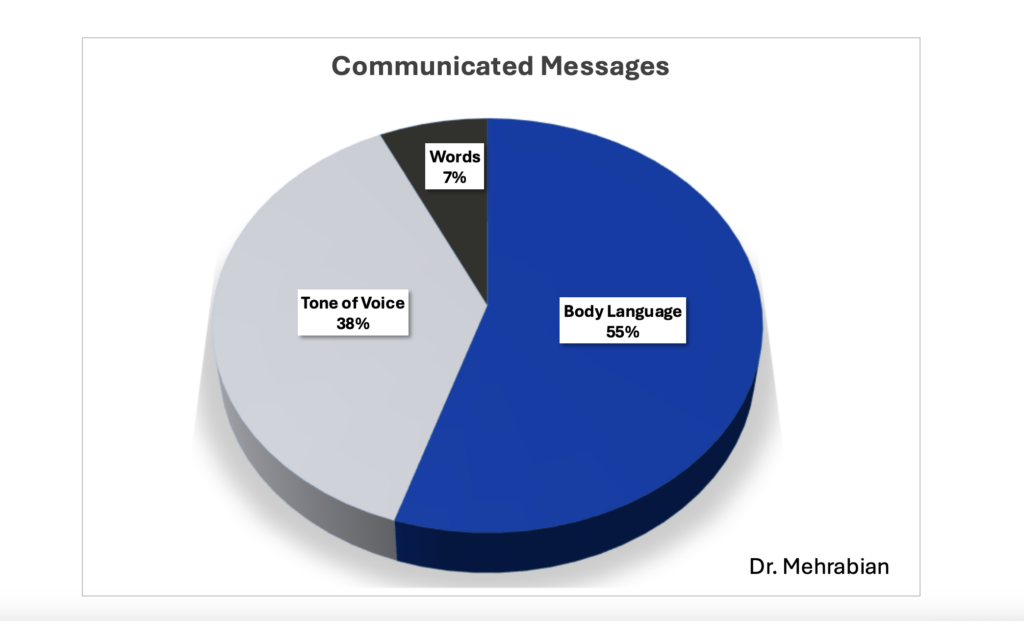As leaders, we all want to be more effective communicators, especially in a virtual/hybrid/changes-by-the-day world. So, what is communication at its core? Today, we’re diving deep into the fascinating world of non-verbal communication as leaders, focusing on the often-unnoticed nuances that play a significant role in how we convey and interpret messages. Whether you’re in a virtual meeting or a face-to-face interaction, understanding these elements can drastically reduce missteps and improve your communications in the corporate world and beyond.
Surprising Data: The Mehrabian Study
Let’s start with the research. Dr. Albert Mehrabian is a psychologist known for his research on non-verbal communication. A key study he conducted reveals a surprising distribution of how our messages are received:

Did you catch that? Only seven percent of our communicated messages center around our word choices. Here we are always worrying about what words we are going to use, and they play a very small role in the message we are trying to convey. His study reveals that the majority of our communication is through our non-verbals. This is especially important when we consider how to effectively use non-verbals as leaders in an increasingly digital environment.
The Power of Non-Verbal Communication in Leadership:
Even when you’re not speaking, you’re always communicating. For example, let’s say someone at work expresses that they are excited you got promoted. If they look at their watch, use air quotes on “excited,” and employ a sarcastic tone, it does not mean the same thing as looking you in the eye, high-fiving you and using their game-day cheering voice. Now, this is an obvious difference but in the increasingly digital world subtle differences are harder to pick up.
Leadership tips to remember for effective communication:
- We are Always Speaking: Every gesture, facial expression, and posture is part of your communication
- Consistency is Key: Ensure your words, tone, and body language align to convey a clear and consistent message
- Perception is Reality: How others perceive your communication can differ vastly from what you intended, based solely on your non-verbal cues. Get feedback from others to understand any unintended messages.
Communication Challenges with Video Conferencing
In the era of Zoom meetings and virtual interactions, the constraints of a digital box significantly alter the way we communicate non-verbally. Though video teleconferencing has enabled some wonderful efficiencies in workflow, it’s not without its share of communication’s challenges. Effective corporate communications require intentionality and creativity.
I was recently talking to a client who shared that when on a video conference, she has a hard time knowing when to jump into the conversation. She explained that she relies on non-verbals such as posture, eye contact, and multi-tasking on their phone as physical queues on how the conversation is going and how much to engage. On a video call, we’re often missing all of those in-person dynamics, which can lead to awkwardness in conversation synchronization. (Ever had those moments where everyone starts to talk at once, then stops, and then say in unison, “Oh, go ahead” at the exact same moment? There’s a reason this doesn’t happen in person!)
Try these tips to enhance non-verbal communication during your next virtual meeting:
- Facial Expressions: With limited visibility, your facial expressions play a heightened role in communication. Be aware if you squinting, smiling, rolling your eyes or other expressions that can send a strong signal to the other side of the conference call.
- Hand Gestures: Keep your hands in view to express enthusiasm and engagement (within reason!)
- Eye Contact: Looking directly into the camera can simulate eye contact, making your communication more personal and impactful
- Mind the Multitasking: Think “no one will notice” if your gaze drops to your phone or to the right on your second screen? Think again. In the bombardment of emails and instant messages, it is hard to turn them off and focus, but your diverted attention will send a message of distraction.
On Phone Calls, Tone of Voice is Everything
When it comes to phone calls, where body language is absent, your tone of voice becomes even more crucial. Increasingly companies are letting employees take a “camera off” day when it comes to conference calls. The challenge with this practice is that you lose body language – 55% of your communication!
I realized through my many years in customer service how critical tone is when it comes to showing people you care and are engaged. The service providers who were able to convey empathy through their tone had fewer escalated cases and received higher satisfaction ratings than those who struggled to get past a flat and dispassionate delivery.
Strategies to convey tone effectively on the phone:
- Smile in Your Voice: Okay, go with me. I know it sounds silly, but a simple smile can transform a flat tone into one that sounds warm and inviting. My team literally had signs on their computer monitors that said “Smile in your voice”, and it worked!
- Visualize the Listener: When things get heated on a voice call, imagine that you’re speaking to someone you care deeply about, like a grandparent. Automatically that can naturally soften your tone and make your words more considerate and patient. This reconnects you to humans on the other side of the line instead of digging in on the issue alone.
Tone: A Key Player in Written Communication
Written communication is constant, and while we can’t audibly hear tone in writing, we always infer it. Does this sound familiar? You painstakingly pick out each individual word to be as accurate as possible in an email. Meanwhile everyone is paying attention to keywords, phrases, bolding/underlines, punctuation and emojis all trying to figure out “what you mean.” What do you mean, what do I mean – can’t they just read the email? They are reading the email with the tone they are interpreting. So, it pays to be intentional to set the tone of your emails.
When I shared these strategies in a leadership development program, a leader raised his hand in the classroom and confessed that when he gets busy, he often shoots one-line emails to “get things off his plate.” While he is being efficient, he realized that the tone he was using was short, curt, and overly directive. It put into context the feedback he gets that the team felt he was always stressed out and bombarding them with commands. The tone his team inferred was not representative of the way that he felt. He took an action item to craft the emails to convey his direction and his tone.
Consider these strategies to ensure written message are conveyed appropriately:
- When in Doubt, Tone it Down: Read and re-read important communications and put yourself in the reader’s shoes. Get a second opinion to see if your tone could be misinterpreted. If you’re not sure how a message may be received, use more neutral language to avoid issues.
- Be Mindful of Structure: The use of bold, italics, underlining, and punctuation can add emphasis and affect interpretation. Apply them thoughtfully.
- Emojis are the New Nonverbals: When appropriate, emojis can help clarify the tone, especially in informal communications. They can indicate humor, sarcasm, or other emotions that might not be clear through text alone. Over using them can look like a toddler grabbed your keyboard, so utilize them in the right context to make the right impact.
Reagan’s Rule: Effective Leaders Use Mindful Communication
Leading in a digital world requires a reexamination of our total communication package. Focus less on that perfect word for accuracy and more on the tone and facial expressions for impact. By being mindful of how we use these tools, we can enhance our interactions and ensure our messages are received as intended. Whether you’re speaking at a summit, serving customers, or engaging in everyday conversations, remember that every aspect of your communication contributes to the overall message. So next time you prepare to communicate, take a moment to align your words, tone, and body language to truly connect with your audience.
About Reagan:
Reagan Cannon is a global executive, seasoned people leader, author and celebrated motivational speaker. She uses proven frameworks and engaging storytelling to teach effective strategies to leaders and their teams.
If you are interested in booking Reagan to host a workshop or speak to your leadership or team, book a free 30-min call HERE.
